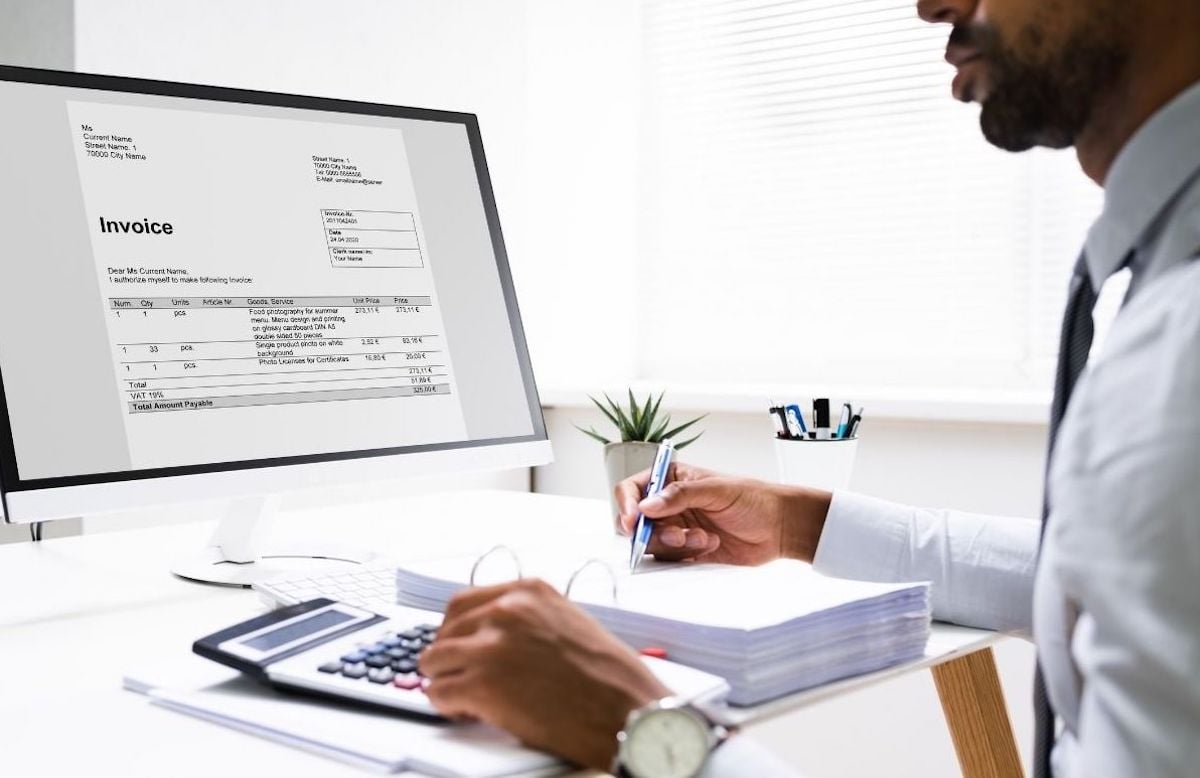Worldwide, over 70% of invoices still arrive on paper. That’s a lot of wasted trees and a lot of lost time processing them, and digging around for them. In the digitally soaked business ecosystem, it seems accounts payable got left behind. Electronic invoicing and digital invoices can help, and benefits will save you thousands of dollars and hours.
But what is digital invoicing?
Digital invoices are non-paper-based invoices stored and distributed in a digital format.
Nearly every business department continues to embrace digitization and digital transformation (DX). But paper-based invoicing persists. Strange. Accounting is, of course, critical for financial health and business relations. Unlike business cards, there’s little need for paper invoices to live another day.
The tech is here, and it’s being used right now. Digital invoicing is quickly getting rid of paper-based invoices at many big companies. According to McKinsey, high-growth companies process nearly 90% of their invoices in a digital format. Lagging organizations barely scrape 50%.
So, what holds you and your company back? Perhaps you never thought of it. Perhaps it’s a trust and security issue. Or a lack of clear understanding.
Here’s what you need to know about digital invoicing, and how it can transform your accounts payable environment. And saves trees.❤️🌳
Deeper dive: What's a digital invoice?
As mentioned, digital invoices take the paper out of invoicing and turn it into data, thus digitizing them.
Typically, digital invoices are stored in PDF or Word format, which can then be easily accessed and read. Many digital invoices are created via scanning paper invoices using the same type of OCR tech we develop and use in Sansan.
Unlike e-invoices, digital invoices are (semi-) unstructured. They aren’t usually, originally meant to be processed by software (just created using it). They’re basically free-form. You can put any information in the body of the invoice. And they read just like paper invoices.

There are plenty of advantages to digital invoices – especially compared with paper invoices. Digital invoices are cheap to store, easy-to-distribute, and simple to share.
Importantly, like a business card or a Word doc, they’re also scannable down to their data, so they can be the start of a completely paperless invoicing system. The wealth of data can also integrate nicely with CRMs and other enterprise software.
How is a digital invoice different from an electronic invoice?
Often, people use “digital invoice” and “electronic invoices” (or “e-invoice”) interchangeably. But they’re different. Actually, they’re very different.
Digital invoices are easy for people to read. They’re documents. Electronic invoices are stored in a .XML or .CSV format. Account software like QuickBooks can read them easily in these formats.
All e-invoices are structured. The layout, formatting, and fields are all static. This way, your accounting software can easily process data from the invoice. Digital invoices, as mentioned, are unstructured and originally meant for humans to read.
Despite the differences, e-invoices and digital invoices are connected in some ways. When you scan a paper invoice, you create a digital invoice. Many software solutions then use those digital invoices to create e-invoices.
Similarly, accounting software often converts e-invoices into digital invoices when you download them. This lets people easily view and understand the invoice.
In short, digital invoices and e-invoices are, essentially, different things, but they (can and should) work in tandem.
So, why should I use digital invoices?
Research on 2,570 U.S. firms found that 72% of invoices still arrive on paper via “snail mail.” From Asia-Pacific, Statista found just 21% of companies had adopted e-invoicing; that’s across many industries.
The costs associated with these paper invoices are staggering in terms of wasted time, labor, and even privacy breaches. For instance, in the UK, 54% of businesses had invoices sent to the wrong place. And an IDC survey suggests “knowledge-based” employees spend nearly 5 hours per week looking for lost documents. In some areas, 1 in 20 paper documents are lost each day.
When we dig a little deeper, things get scary. 41% of businesses admit invoicing delays are a common source of cash flow problems.
Worse still, 12.5% of invoices require reworking. When those invoices are in a paper-based format, reworking often means long, arduous, and time-consuming processes. Digital invoices can be easily edited for accuracy.
Paper-based invoices introduce tangible problems. Simply digitizing invoices solves a lot of these problems.

Universal benefits of digital invoicing
- Easier editing: Editing paper invoices is demanding. Digital invoices are easy to edit using Word, Gdocs, PDF editing software, etc.
- Easier storage and maintenance: The average filing cabinet reportedly costs around US$25,000 to fill and US$2K to maintain. But consider that 2 TB of Google storage costs US$9.99 per month. That’s enough to store millions of PDF files, far more than you’ll likely ever have. Digital invoices can be stored in the cloud, accessed from anywhere, and maintained using basic data handling policies.
- Easier to plug into invoicing systems: ERPs and accounting software can easily transform digital invoices into e-invoices. An effective digitizing service can serve as the middleman.
- Better for the environment: Paper accounts for 40% of waste in the United States. Digital invoices incur little-to-no waste. The same’s true of digital business cards. And even paper cards can be put back into the environment.
- Improved vendor relationships: Late payments, missed payments, and duplicate payments can all damage vendor relationships. Digital invoices minimize these pain points. They make it easier for employees to create, identify, and share invoices, and they can be used with digital systems to automate payments.
- Better automation potential: Digital invoices pair well with automated invoicing software — like ERPs and QuickBooks.
There’s no lack of benefits to digital invoicing. And the less paper you carry on your shoulders, the more robust and sustainable your invoicing ecosystem becomes.
How are digital invoices processed?
This depends on your setup. Many digital invoices are automated. With automated tools, you can nearly fully automate your AP pipeline. Typically, this starts by scanning and uploading existing paper documents. You may use optical character recognition (OCR) tools or other image recognition engines. These technologies automatically convert paper to digital.

Once paper invoices are digitized, they can be fed into invoice processing automation software.
Again, the benefits of automated invoicing are immense. The average full-time employee can process roughly 15,000 invoices a year. Automation can raise that incrementally, depending on your setup and software. They can also avoid duplication issues. The admin stuck with tedious data entry can also be trained up on more modern skills.
Believe it or not, 63% of businesses receive duplicate invoices, and an unfortunate 33% pay for those duplicates.
In manual invoicing ecosystems, 3.6% of fully submitted invoices contain errors, and 12.5% require reworking.
The exact lifecycle of a digital invoice depends on the software you use. But you can expect it to start by scanning paper into digital systems, converting that data into a searchable digital invoice, and routing that digital invoice to the right people to secure signatures and approvals.
Consider that 1 in 3 manual invoices contain errors. With digital invoices, you can drop that number to nearly zero.
How do I make a digital invoice?
Most digital invoices are made by scanning paper invoices with OCR, like what we use to scan business cards at Sansan. Another option is to use digital invoice templates using software like FreshBooks.

In other words, we’ve seen businesses manually input data from paper invoices into digital templates. And we’ve seen companies embrace end-to-end digitization with advanced OCR scanning and complex invoice routing algorithms. And everything in between.
Creating a digital invoice is simple. You can use scanners, templates, or automated software solutions like QuickBooks or FreshBooks. But many companies go beyond simply creating ad-hoc digital invoices.
You can communicate with vendors to have them send you digital invoices via email. Or you can use an outsourced invoice management solution to transform paper documents into digital invoices automatically. There are plenty of different ways to create digital invoices. Each has benefits.
The future of digital invoicing is bright, and it’s here for you to use
Inefficiently handled invoices can quickly harm relationships with key vendors, eliminate discount opportunities, invoke late payments, and frustrate budget teams.
Digital invoicing promises to eliminate significant pain points in the average business’s invoicing pipeline. Between minimizing errors, reducing manual inputs, and automating the invoice lifecycle, digital invoices (and e-invoicing systems as part of your business infrastructure), will continue to grow.
The future of invoicing and accounts payable is brighter than ever. Maybe it's time to make it part of your DX.
Sansan's at the middle of your DX. We digitize and automate away the analog systems of old. And we keep adding new tools. Have a look:





